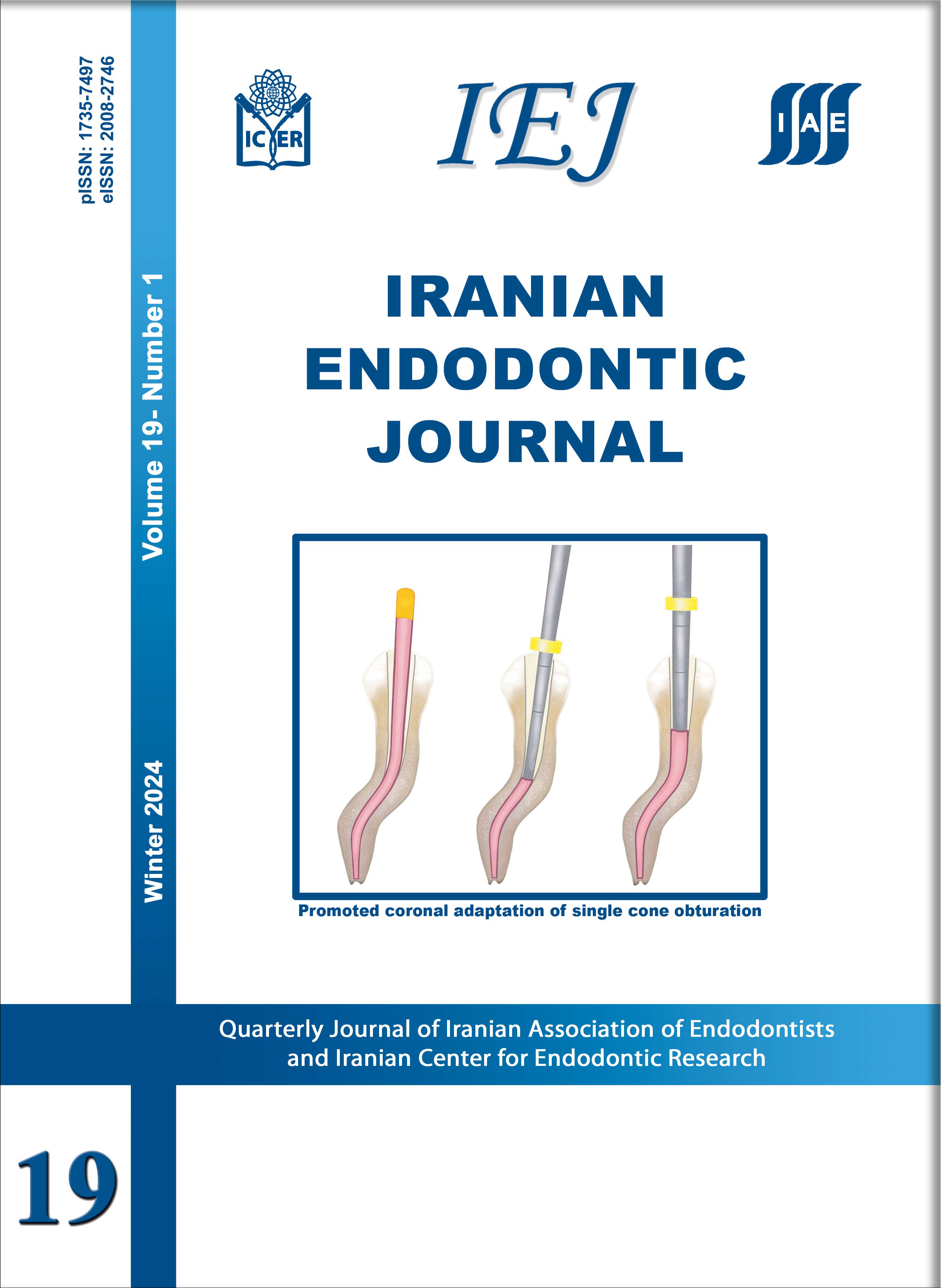Shaping Ability of ProTaper Next, Hyflex CM, and V-Taper 2H Nickel-Titanium Files in Mandibular Molars: A Micro-computed Tomographic Study
Iranian Endodontic Journal,
Vol. 16 No. 2 (2021),
16 Esfand 2021
,
Page 103-108
https://doi.org/10.22037/iej.v16i2.30586
Abstract
Introduction: Although micro-computed tomography (MCT) evaluation of the shaping ability of ProTaper Next (PTN) and Hyflex CM (HCM) files has been reported, to our knowledge, no study has assessed the performance of V-Taper 2H (VT) files. The aim of this study was to evaluate and compare the shaping ability of PTN, HCM, and VT systems in the mesial canals of mandibular molars using MCT. Methods and Materials: Thirty extracted first and second mandibular molars were scanned using MCT and randomly assigned to HCM, PTN, and VT groups. Images obtained before and after preparation were evaluated for the increase in the root canal volume, untouched surface area, and amount of accumulated hard tissue debris. One-way analysis of variance (ANOVA) and Kruskal-Wallis test were used to compare the variables in the groups (α=5%). Results: There were no statistically significant between-group differences in the postoperative measurements (P>0.05). The canal volume increased in all three groups: PTN (73.84%), VT (73.48%), and HCM (49.29%). The largest and smallest untouched areas were observed in the PTN (41.37%) and VT (30.85%) groups, respectively (P>0.05). The debris formed during canal preparation was 1.84%, 2.16%, and 2.42% in the VT, PTN, and HCM groups, respectively (P>0.05). Conclusions: Based on our in vitro study, the PTN, HCM, and VT systems showed similar shaping abilities. None of the tested canals were completely free from debris, while the untouched surface area was considerably large. The VT system had the most favorable results with the smallest untouched surface area and least debris were. We would recommend further trials to endorse these findings.
- Micro-computed Tomography; Nickel-Titanium Instruments; Root Canal Preparation; Rotary Instrumentation
How to Cite
References
Hulsmann M, Peters OA, Dummer PMH. Mechanical preparation of root canals: shaping goals, techniques and means. Endod Top. 2005;10:30–76.
Shen Y, Zhou HM, Zheng YF, et al. Current challenges and concepts of the thermomechanical treatment of nickel-titanium instruments. J Endod. 2013;39:163–172.
Haapasalo M, Shen Y. Evolution of nickel-titanium instruments: from past to future. Endod Top. 2013;29:3–17.
Neto F, Ginjeira A. Comparative analysis of simulated root canals shaping, using ProTaper Universal, Next and Gold. Rev Port Estomatol Med Dent e Cir Maxilofac. 2016;57:82–86.
Gambarini G, Gerosa R, De Luca M, et al. Mechanical properties of a new and improved nickel-titanium alloy for endodontic use: an evaluation of file flexibility. Oral Surg Oral Med Oral Pathol Oral Radiol Endod. 2008;105:798–800.
Shenoi PR, Luniya DA, Badole GP, et al. Comparative evaluation of shaping ability of V-Taper 2H, ProTaper Next, and HyFlex CM in curved canals using cone-beam computed tomography: An in vitro Study. Indian J Dent Res. 2017;28:181–186.
Versiani MA, Carvalho KKT, Mazzi-Chaves JF, et al. Micro–computed Tomographic Evaluation of the Shaping Ability of XP-endo Shaper, iRaCe, and EdgeFile Systems in Long Oval-shaped Canals. J Endod. 2018;44:489–495.
Drukteinis S, Peciuliene V, Dummer PMH, et al. Shaping ability of BioRace, ProTaper NEXT and Genius nickel-titanium instruments in curved canals of mandibular molars: a MicroCT study. Int Endod J. 2019;52:86–93.
Stringheta CP, Bueno CES, Kato AS, et al. Micro-computed tomographic evaluation of the shaping ability of four instrumentation systems in curved root canals. Int Endod J. 2019;52:908–916.
Gagliardi J, Versiani MA, De Sousa-Neto MD, et al. Evaluation of the shaping characteristics of ProTaper Gold, ProTaper NEXT, and ProTaper Universal in curved canals. J Endod. 2015;41:1718–1724.
Turkistani AK, Gomaa MM, Shafei LA, et alE. Shaping ability of HyFlex EDM and ProTaper next rotary instruments in curved root canals: A micro-CT study. J Contemp Dent Pract. 2019;20:680–685.
Lopes RMV, Marins FC, Belladonna FG, et al. Untouched canal areas and debris accumulation after root canal preparation with rotary and adaptive systems. Aust Endod J. 2018;44:260–266.
Brasil SC, Marceliano-Alves MF, Marques ML, et al. Canal Transportation, Unprepared Areas, and Dentin Removal after Preparation with BT-RaCe and ProTaper Next Systems. J Endod. 2017;43:1683–1687.
Zhao D, Shen Y, Peng B, et al. Micro-computed tomography evaluation of the preparation of mesiobuccal root canals in maxillary first molars with Hyflex CM, twisted files, and K3 instruments. J Endod. 2013;39:385–388.
Schneider SW. A comparison of canal preparations in straight and curved root canals. Oral Surg Oral Med Oral Pathol 1971;32:271–275.
Gu Y, Kum KY, Perinpanayagam H, et al. Various heat-treated nickel–titanium rotary instruments evaluated in S-shaped simulated resin canals. J Dent Sci. 2017;12(1):14–20.
Setzer FC, Kwon TK, Karabucak B. Comparison of apical transportation between two rotary file systems and two hybrid rotary instrumentation sequences. J Endod. 2010;36:1226–1229.
Xu K, Wang J, Wang K, et al. Micro-computed tomographic evaluation of the effect of the final apical size prepared by rotary nickel-titanium files on the removal efficacy of hard-tissue debris. J Int Med Res. 2018;46:2219–2229.
Kyaw Moe MM, Ha JH, Jin MU, et al. Root Canal Shaping Effect of Instruments with Offset Mass of Rotation in the Mandibular First Molar: A Micro–computed Tomographic Study. J Endod. 2018;44:822–827.
Siqueira JF, Alves FRF, Versiani MA, et al. Correlative bacteriologic and micro-computed tomographic analysis of mandibular molar mesial canals prepared by self-adjusting file, reciproc, and twisted file systems. J Endod. 2013;39:1044–1050.
Alves FRF, Almeida BM, Neves MAS, et al. Disinfecting oval-shaped root canals: Effectiveness of different supplementary approaches. J Endod. 2011;37:496–501.
Paqué F, Peters OA. Micro-computed tomography evaluation of the preparation of long oval root canals in mandibular molars with the self-adjusting file. J Endod. 2011;37:517–521.
Shaheen N. The efficacy of different single file systems in cleaning oval shaped root canal. Tanta Dent J. 2019;16:73.
Bier CAS, Shemesh H, Tanomaru-Filho M, et al. The Ability of Different Nickel-Titanium Rotary Instruments To Induce Dentinal Damage During Canal Preparation. J Endod. 2009;35:236–238.
- Abstract Viewed: 293 times
- PDF Downloaded: 184 times




